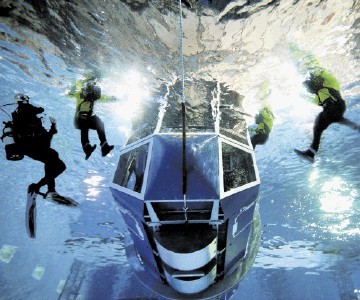
Last month, Reflex Marine demonstrated how the latest edition of its Frog offshore personnel transfer system can handle stretcher cases.
Energy caught up with “casualty” Henrik Andersen and “nurse” Bjorn Andersen of Danish company Fano Kran-Services at the Survivex training facility in Aberdeen, where they were being familiarised with the new XT-series Frog family.
It has long been possible to transfer stretcher cases with the Frog. However, a number of refinements to the basic design and which are incorporated into the XT-series, mean there is now a standardised way of folding down seats and stretcher latching mechanism for the four, six and 10-seat variants.
Since their introduction, Reflex has sold 25 four-seat XT4 units; a trio of XT6 vehicles were due to go into service last month; while the 10-seater is attracting attention but with no sales up to the date of the stretcher demonstration.
More than 800 Frogs are now operating globally as the safe option for personnel transfer by crane. And, while the offshore oil and gas industry remains hugely important, offshore renewables are gaining traction as a market.
Charles House, Europe business manager for Reflex, told Energy that there has been a “lot of interest” from the offshore wind brigade, particularly German companies who see Frog as a viable contingency to heli-transportation.
The Swedish Coastguard also uses Frogs to get divers aboard vessels in distress and the US National Parks Service has one tailored for wheelchair access.
Frog was developed in Aberdeen in the early 1990s, its first demonstration being staged at a flooded quarry near Tyrebagger. With CEO and founder Phil Strong as the driving force behind Reflex Marine, the technology represented then and still represents a huge step forward when it comes to personnel transfer offshore using cranes.
According to Reflex, traditional rope baskets pose four main threats to safety: falling, side impact, hard landing and immersion.
Through exhaustive research, design and innovation the firm has tackled each risk: four-point seat harnesses with quick release buckles (as used in free-fall lifeboats) reduce the risk of falling; a stainless steel frame and buoyancy panels help to absorb side impacts; and to reduce vertical impact the firm mounted the seating on coil springs and hydraulic dampers, and developed polymer foam shock-absorbing landing feet.
Both the XT and TORO series devices are fitted with buoyancy panels and self-righting capabilities and have been tested to Beaufort 7 sea state. The company claims that even medevacs are possible in such harsh conditions.